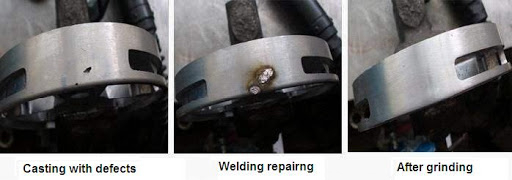Methods of dealing with defects are as the following:
Defect judgment
In production practice, repair welding is not allowed for some casting defects, such as penetrating cracks, penetrating defects (bottom penetration), gas holes shaped like honeycombs, sand and slag inclusions that cannot be removed, shrinkage porosity with an area of more than 65 square centimeters and other major defects which cannot be repaired as agreed in the contract between the two parties. The type of defect should be judged before repair welding.
Defect removal
In the factory, carbon arc air gouging is generally used to blow casting defects, and then a portable angle grinder is used to polish the defective parts to reveal the metallic luster. However, in production practice, carbon steel welding rods are used to remove defects directly with high current and an angle grinder is used to obtain the metallic luster. Generally, casting defects can be eliminated by using a J422 welding rod less than 4mm, a current between 160 and 180A, and then use an angle grinder to make the defects a U shape to reduce welding stress. Repair welding will be of good quality if defects are removed thoroughly.
Preheating of defective parts
If areas of repair welding parts of carbon steel and austenitic stainless steel castings are less than 65cm2, and their depth is is less than 20% of the thickness of the casting or 25mm, generally no preheating is required. However, pearlitic steel castings such as ZG15Cr1Mo1V and ZGCr5Mo should be preheated because of great tendency of hardening of steel and easy cracking in cold welding. The preheating temperature is between 200℃ and 400℃. A small value is adopted when repair welding with stainless steel welding rod is used. The holding time should not be less than 60 minutes.
If the casting cannot be preheated as a whole, oxygen-acetylene can be used to expand the defect part by 20mm and then heat it to between 300℃ to 350℃. Observe the slightly dark red on the dark side. Make the large torch neutral flame gun spray at the defect part and its surroundings by circles and quickly for several minutes, and then make the flame gun move slowly for 10 minutes, depending on the thickness of the defect, so that the defective part can be fully preheated; then quickly repair weld the defect.
Methods of repair welding
Requirements
When austenitic stainless steel castings are repair welded, they must be cooled quickly in a ventilated place. For pearlitic low alloy steel castings and carbon steel castings with too large repair welding area, the leeward place or windshield should be used to avoid cracks caused by rapid cooling. The welding slag should be removed immediately after repair welding, and hammer uniformly along the defect center outwards to reduce repair welding stress. If the repair welding is carried out in several layers (generally a repair welding layer has a thickness of between 3 and 4 mm), the welding slag should be removed in time after each layer of repair welding and hammer the repair welding area. If welding is performed in winter, for ZG15Cr1Mo1V pearlite alloy steel castings, oxygen-acetylene should be repeatedly heated for each repair welding layer, and then quickly repair weld to avoid welding cracks.
Welding rods
First check whether the welding rod is preheated before repair welding. Generally, the welding rod should be dried at temperatures between 150℃ to 250℃ for 1 hour. The preheated welding rod should be placed in the insulation box, so that it can be taken whenever it is needed. The welding rod should be preheated for 3 times repeatedly. If the surface of the welding rod peels off, cracks and rusts, it should not be used.
Times of Repair welding
Pressure-bearing castings such as valve housings have been tested for pressure, and leakage occurs; the same part is generally only allowed to be repaired once. Repair welding cannot be repeated, because multiple repair welding will make the grain in the steel big and affect the pressure-bearing performance of the casting, unless the casting can be reheated after welding. For repair welding of other non pressure-bearing with same welding parts, it is generally stipulated that repair welding should not exceed 3 times. For the same parts of carbon steel castings that are repair welded more than twice, stress relief treatment should be performed after welding.
The height of repair welding
The repair welding height of the casting is generally about 2mm higher than the surface of the casting to facilitate machining. If the repair welding layer is too low, the welding scar will be easy to be exposed after machining. If the repairing layer is too high, it will be time-consuming and cost more.

